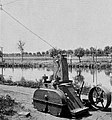Tow locomotive
A towing locomotive is the term used to describe locomotives that travel along bodies of water and are used to tow (pull) watercraft . In inland shipping , towing has largely been abandoned; the most famous towing route in the world is now the cog railway on the banks of the locks of the Panama Canal .
history
The first tow locomotives were used on the Bourgogne Canal in 1873 . They were equipped with a steam engine and only ran with one axle on a rail, the other was designed in the manner of a locomobile for the track. This type of construction did not prove itself.
In 1880, a total of 77 km of meter gauge tracks were laid between the Douai and Les Fontinettes locks . The towing speed was 1.5 km / h on the ascent. Due to ongoing technical difficulties, operations were stopped on February 1, 1886. A four-axle steam locomotive weighing 14 t was used .
In 1890 a two-axle steam locomotive was used on the Oder-Spree Canal on 900 mm wide tracks, which reached a towing speed of 7 km / h with up to seven barges. Here, too, no economical operation could be achieved.
Between 1898 and 1901, an electric Siemens grain locomotive System Köttgen was tested on the Finow Canal . One rail took up approx. 85 percent of the weight, while the locomotive was supported on two large rollers towards the ship. Although Carl Köttgen's system had proven itself, the decision was made to use vehicles on conventional tracks after the end of the tests.
vehicles
The vast majority of towing railways were built in France, where as early as 1934 an electrically operated towing system stretched from Calais and Dunkirk to Huningue near Basel . In addition to electric locomotives came to French inland waterways and tractors on tires used by either internal combustion engines by means of - or catenary were electrically driven -. The latter machines were converted to rail vehicles .
In May 1931, 512 electric and two heavy oil towing locomotives were counted in France . They came from the manufacturers Applevage , Jeumont , Hillaret, Alsthom , AEG - after the First World War, the company delivered 40 tow locomotives to France as reparations for the Canal du Rhône au Rhin - and Deutz .
Whereabouts
Towing locomotives built by Siemens can be viewed at the Teltow Canal in Berlin and at the Niederfinow ship lift . In Saverne , tow locomotives of the Canal de la Marne au Rhin are monuments at the lock and at the Grand Bassin .
gallery
Köttgen towing locomotive on the Finow Canal , 1899 (D)
Former AEG grain locomotive on the Canal du Rhône au Rhin in Saverne (F)
Tow locomotive on the Panama Canal
See also
literature
- A. and H. Säuberlich: Roller coaster in Panama. Tow locomotives on the rack . In: LOK MAGAZINE . No. 252 / Volume 41/2002. GeraNova Zeitschriftenverlag GmbH Munich, ISSN 0458-1822 , pp. 64–65.
- Rolf Löttgers tow lifts in Europe and overseas . In: Yearbook for Railway History . No. 5/1972 edition. Pp. 33-64. Verlag Rösler + Zimmer, Augsburg, published by the German Society for Railway History eV, Karlsruhe, ISBN 3-87987-126-4 .
- Gérard Bianchi: Les Cahiers du Musée de la Batellerie. La traction mécanique sur berge en France . Association des amis du Musée de la Batellerie, Conflans-Sainte-Honorine 2015, ISBN 2-909044-69-6 .
Web links
Individual evidence
- ↑ Treidelbahn Finowkanal, 16248 Niederfinow at bahn-express.de, accessed on February 23, 2019
- ↑ Gérard Bianchi: Les Cahiers du Musée de la Batellerie. La traction mécanique sur berge en France . Association des amis du Musée de la Batellerie, Conflans-Sainte-Honorine 2015, ISBN 2-909044-69-6 , p. 12 .
- ↑ Gérard Bianchi: op.cit , p. 68.
- ↑ Gérard Bianchi: op.cit , p. 44.
- ↑ Gérard Bianchi: op.cit , pp. 85 ff.
- ↑ Gérard Bianchi: op.cit , p. 50.
- ↑ Voies navigables de France at rail.lu, accessed on March 1, 2019





